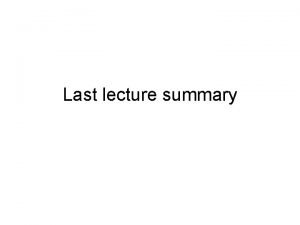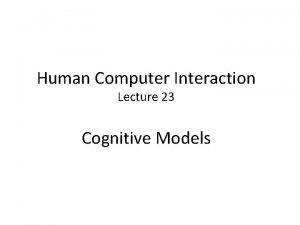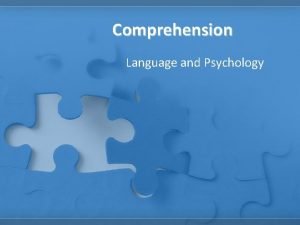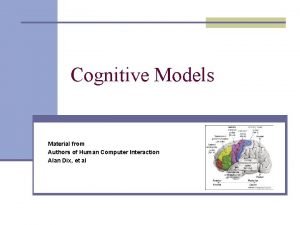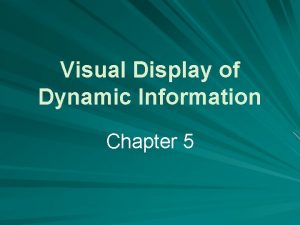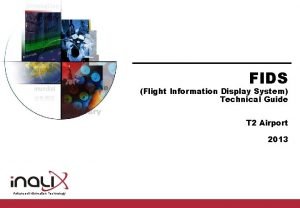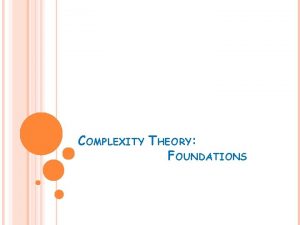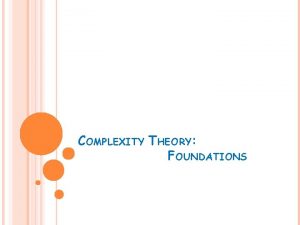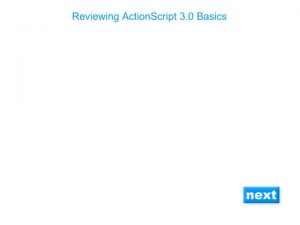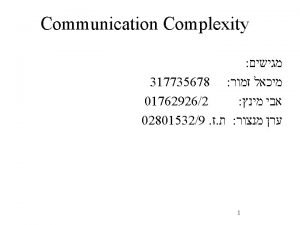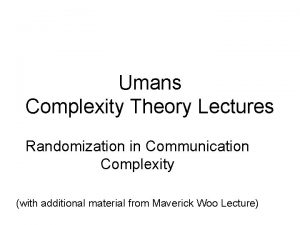Information display decision complexity Information Theory aka Communication
















- Slides: 16

Information display: decision complexity Information Theory (aka Communication Theory) n ¨ Grew out of the study of problems of electrical communications (especially telegraphy) and statistical mechanics. message source ¨ ISE 412 encoder channel decoder message receiver The message source selects one of a possible set of messages, encodes it, and transmits the resulting signal through a channel. The message is decoded and then received by the receiver. 1

Information Theory: definitions n n n Information: “reduction of uncertainty” (that the receiver has about the message transmitted by the source. ) Bit: a single unit of information, equivalent to a choice between two alternatives (yes/no, on/off) Entropy (H): measure of information in bits (typically, bits per second, bits per word, bits per symbol) "a measure of our ignorance" ¨ H is based on the number of possible messages (or events or stimuli) N, the probabilities of those messages, and the context (i. e. , the probabilities of all messages). ¨ ISE 412 2

n % Redundancy: n SO WHAT? Why should we care? ¨ n Example: ¨ ISE 412 Because if we can quantify information, we can quantify human information processing!! In terms of performance, we can look at choice reaction time (how long it takes to make a choice or decision) as a function of the amount of information. A tetris-like game is being designed in which the probability of appearance of each shape is directly proportional to the number of edges. If the pieces are shaped as follows, what is the average amount of information and the % redundancy in the system? 3

Quantifying Information n For N equally likely alternatives, For example: ¨ If equally likely, H =_______ n If known probabilities: ¨ If pi = [0. 13, 0. 27, 0. 4] H 1 = _________ n The "average entropy" of a system: Hav = ________________________ ISE 412 4

Principles of Display Design n Based on research findings from … ¨ physical and psychophysical characteristics, capabilities, and limitations n n n visual system hearing & loudness etc. ¨ memory ¨ perception ¨ attention n ISE 412 The principles listed on the following slides are discussed in detail in Buck & Lehto, chapter 18 5

Principles based on Sensory Modality n Use the most appropriate sensory modality based on: ¨ intended function, e. g. … warnings n ISE 412 instructions labels data ¨ sensory demands of background task(s) ¨ sensory capability of the intended audience Combine sensory modalities when possible to account for changing conditions 6

Principles based on Location & Layout n Locate visual displays where they can be seen and put more important visual displays in more central locations ¨ within 30° of typical line of sight ¨ clear away visual obstacles ¨ avoid ISE 412 visual clutter 7

Principles based on Location & Layout n Provide information at the time it needs to be used. n Group displays and display elements consistently with the sequence of use by the operator. ISE 412 8

Principles based on Location & Layout n Tasks requiring information integration are better served by object-like displays. ¨ ISE 412 AKA, Proximity compatibility principle (Wickens & Carswell, 1995). Promote integration of information (where appropriate. ) n gestalt - human tendency to perceive complex configurations as complete entities n Note: This carries over into design of controls, in that the spatial arrangement of displays should be preserved in the controls. (Example: stove controls. ) 9

Principles based on Location & Layout n Objects that are placed together will be more likely to be viewed as being related. ¨ e. g. , n ISE 412 recall … Position displays or display elements so they have obvious spatial referents 10

Related principles (not found in B & L) n Principle of pictorial realism (Roscoe, 1968). ¨ Displayed quantities should correspond to the human's internal model of these quantities. n n ISE 412 Continuous variables should have analog displays; discrete variables should have digital displays. Also, high values of the variables should be on the top of the display (or right); low values on the bottom (or left). Other factors to consider: required precision, rate of change information. Examples to discuss: altimeter, thermometer, scale, watch, speedometer. 11

Related principles (not found in B & L) n Principle of the moving part (Roscoe, 1968). ¨ The direction of movement of an indicator on a display should be compatible with the direction of movement of an operator's internal representation of the variable whose change is indicated. n n Example: Thermometer's mercury rises as temperature rises. Violation: Fixed pointer-moving scale display. 112 120 114 118 116 ISE 412 vs. 116 118 114 120 112 12

“Sticky” example from aviation ¨ Display of the aircraft's bank angle to pilots. ISE 412 n "Outside-in" "ground-referenced" "bird'seye" display (moving plane, fixed ground) - conforms to the principle of the moving part, but violates the pilot's frame of reference. n "Inside-out" "pilot's eye" "moving horizon" display - violates the principle of the moving part but congruent with the pilot's frame of reference. 13

“Sticky” example from aviation (cont. ) ¨A compromise: The Frequency-Separated Display n n n ISE 412 Rapid control movement induces "outside-in" display change. When the pilot enters into a gradual turn, the horizon and plane slowly rotate to an "inside-out" format. Thus, at high frequencies, when motion perception is dominant, the principle of the moving part is followed. At low frequencies, the static principle of compatibility of frame of reference is followed. 14

See also … n Legibility principles – pp. 664 -668 n Information content and coding – pp. 668 -673 ISE 412 15

Other examples to discuss … ISE 412 16
 No decision snap decision responsible decision
No decision snap decision responsible decision Investment decision financing decision dividend decision
Investment decision financing decision dividend decision Time space complexity
Time space complexity Difference between random scan and raster scan
Difference between random scan and raster scan Raster scan display
Raster scan display Raster scan display and vector scan display
Raster scan display and vector scan display Alpha kappa alpha incorporation date
Alpha kappa alpha incorporation date Information theory decision tree
Information theory decision tree Cognitive complexity theory in hci examples
Cognitive complexity theory in hci examples Comprehension psychology
Comprehension psychology Minnesota complexity assessment method
Minnesota complexity assessment method Bnf in hci
Bnf in hci Decision tree and decision table
Decision tree and decision table Dynamic information display
Dynamic information display Cockpit display of traffic information
Cockpit display of traffic information Flight information display system price
Flight information display system price Flight information display system and open source
Flight information display system and open source







